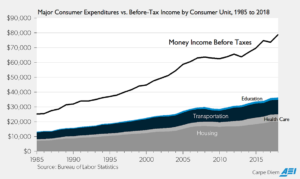Oren Cass – as part of his effort to build a conservative case for industrial policy and protectionism – argues that ordinary Americans have stagnated economically for decades. Predictably, Cass is getting lots of love from those who are committed to the wildly popular belief that ordinary Americans have stagnated economically for decades. Pessimism and bearing bleak news are oh-so-hip and sciencey-sounding.
It’s also, conveniently, oh-so-convenient for those grasping for ever-more state power to be used to coerce peaceful people and to override market processes. If the economy isn’t working, what alternative do we have but to put more of the economy into the hands of politicians and mandarins? What could possibly go wrong?! (Cass, by the way, is only the latest in a long line of pundits to peddle the stagnationist thesis. And I’m sure that he won’t be the last. [See my point just above regarding the political convenience of this thesis.])
Fortunately, a number of competent scholars, such as Scott Winship, are on the job unpacking and exposing the many errors, oversights, and questionable interpretations that infect Cass’s rendition of the stagnationist thesis. One of these hard-working scholars is American Enterprise Institute economist Mark Perry, who sent to me the graph below which he compiled from U.S. Bureau of Labor Statistics data. Mark’s graph suggests a very different account from that which which is offered by Cass.
I’m sure that Mark will post more about this graph specifically, and about this issue more generally, on his excellent blog, Carpe Diem. And so I’m especially grateful for his permission for me to share his graph here.
 …..
…..



